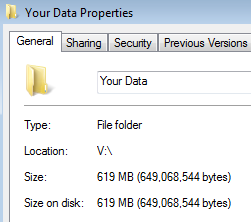Another day another backup!
There is so much mystery, confusion and downright misinformation regarding home computer backups, I felt the need to write an overview of how to do it properly.
It has been said that the world is divided into two groups – those that backup and those that will.
If you need to know why you need to backup, read this. But basically, your data is stored on a hard disk that will fail…and note that if you (really) do have 300 GB of data to backup, this process isn’t for you – this one is.
So, to simplify the whole process and make sure you’re (almost!) ready for anything, do this:
1. How much data?
Calculate how much data you need to backup: right click on a folder you want to backup and select properties – you should see the size of the folder displayed – in this example it is 619MB:
Simply add up the size of all the folders you want to backup – that’s tells you how much total data storage you’re going to need: i.e how big a hard disk(s) you need to buy for your backups.
Note: over a year, the amount of disk space you need, will be the total amount of data backed up multiplied by the number of times you run the backup. (50GB of data backed up weekly, will require 50 GB x 52 weeks of year = 2.6 TB)
2. Select your backup software
Some software suggestions here – then install it.
3. Buy another hard disk
Having worked out what size of disk you need – buy the next biggest disk that exceeds that size – I would recommend an external drive, based upon the latest USB connection that your computer supports. (But you could also use an internal disk, if required).
4. Configure the backup
If you only have a small amount of data to backup, always do ‘full’ backups – not ‘incremental’ ones. This will be explained in the backup software manual.
Otherwise, for large amounts of data, set the backup software to create one full backup, then a number of increments, then repeat. Say 1 full backup every week, followed by 5 daily ‘increments’.
You are doing this for three reasons: firstly it will save disk space, secondly the increments will run faster than the full backups, saving time and thirdly every 6th backup will protect you from corruption on a previous full backup.
You will need to decide how many increments to set, based upon how much your data changes and how much protection you think you need: if your data changes frequently, you may want to set a low number of increments, so that you have more frequent ‘full’ backups.
Think about this carefully – now, as the number of full backups you do could eat up huge chunks of disk space.
Read and follow the recommendations from your backup software provider.
5. Schedule your backups
Set the backup job to run automatically – weekly at a minimum – though this will be dependant upon how frequently your data changes over time – you may want backups daily, weekly, monthly, or all three.
Job done!
Well, not quite. All this backing up is fine and will save you from a hard disk failure, but it will not save you from:
- Viruses like Cryptolocker / Zeus
- Theft
- Fire and flood
- All your hard disks fail simultaneously!
- Act of God etc.
To complete the picture, you will need to move a backup ‘off-site’, periodically.
Nearly there…
Many people decide to take the risk that theft or fire are relatively unlikely, and that’s up to you. However, that shiny new laptop or desktop are highly prized by thieves, as they can be turned into ready cash very easily. You may have some very fine silverware, but trust me, that laptop is going out the door first!
A simple method to achieving this, would be to take your backup drive with you, just when you are away for long periods – on holiday for example. This isn’t perfect, but it does reduce some risk.
A better solution, would be to buy 2 backup disks and rotate them: then simply store one of them offsite – maybe at work or a relatives house.
That’s it folks – a simple straightforward solution.
